Artists: Liv Moriarty and Emma Berry
Exhibition: Starting in the Middle
Gallery: Woven Projects, Naarm/Melbourne
16 – 25 May 2022
Four years ago, artists Emma Berry and Liv Moriarty began emailing poems, lists and observations to each other. In this pre-pandemic era, where for the two artists, communication in the digital sphere was more playful than necessary, an artistic symbiosis slowly began to take form. By keeping with the process of remote sharing back-and-forth from the comfort of each other’s homes, the two artists’ ideas began to blend, imitate, diverge, and splutter outwards: ‘We amalgamate experience, trains-of-thought and interpretation to see where we land.’ The concepts underpinning this exhibition have given me an opportunity to reflect on language as a changing landscape, stuttering outward in a pulsing, erratic movement. Starting in the middle.
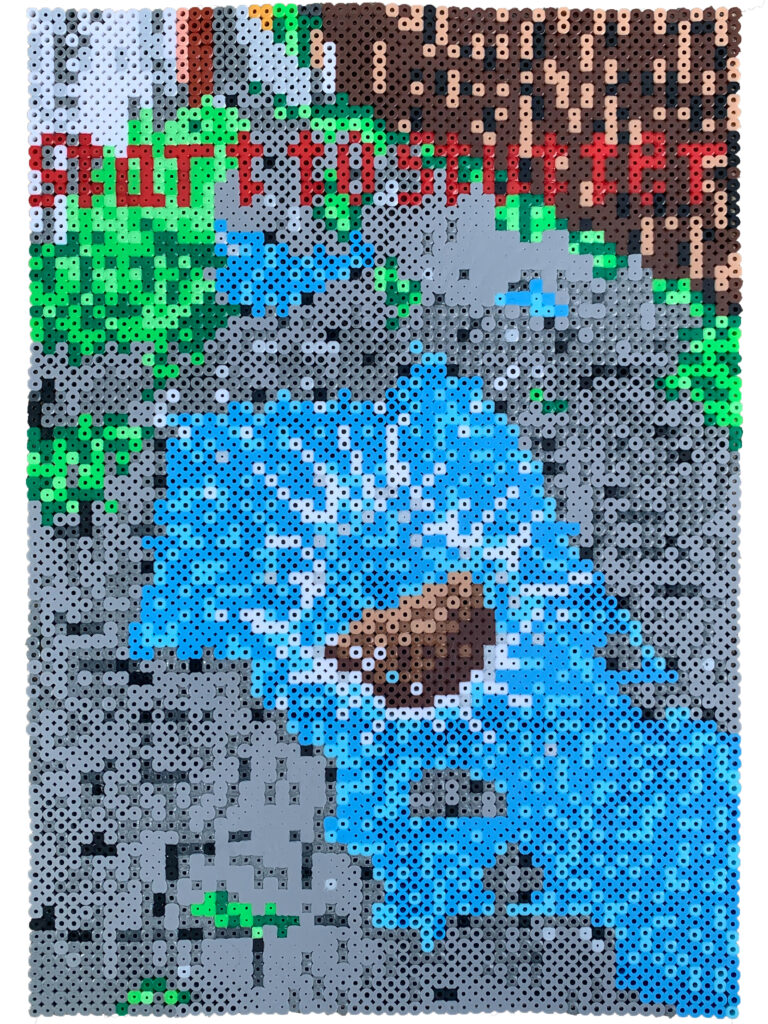
In Starting in the Middle, text, drawing, and video are placed among built support structures—a wooden room divider, plinths, sandbags. My feeling walking through the gallery is of silence and lucidity—the structures around me are minimal, almost practical, and there is a cleanness in the materials used. Objects are attentively placed and equidistant, opening up a sense of spaciousness. The centrepiece of the show is a plexiglass standing sign inscribed with a text in permanent marker that reads like a writer’s manifesto:“MATERIALISE THE HOLE! POKE A STICK AT THE GAP BETWEEN SEEING AND SAYING! YOU SEE? IF YOU SPLIT ANY WORD INTO ITS INFINITE AMOUNT OF POSSIBLE NEXT STEPS, CONSTANTLY REGENERATING VARIABLES, THEN LANGUAGE ITSELF STARTS TO STUTTER.”
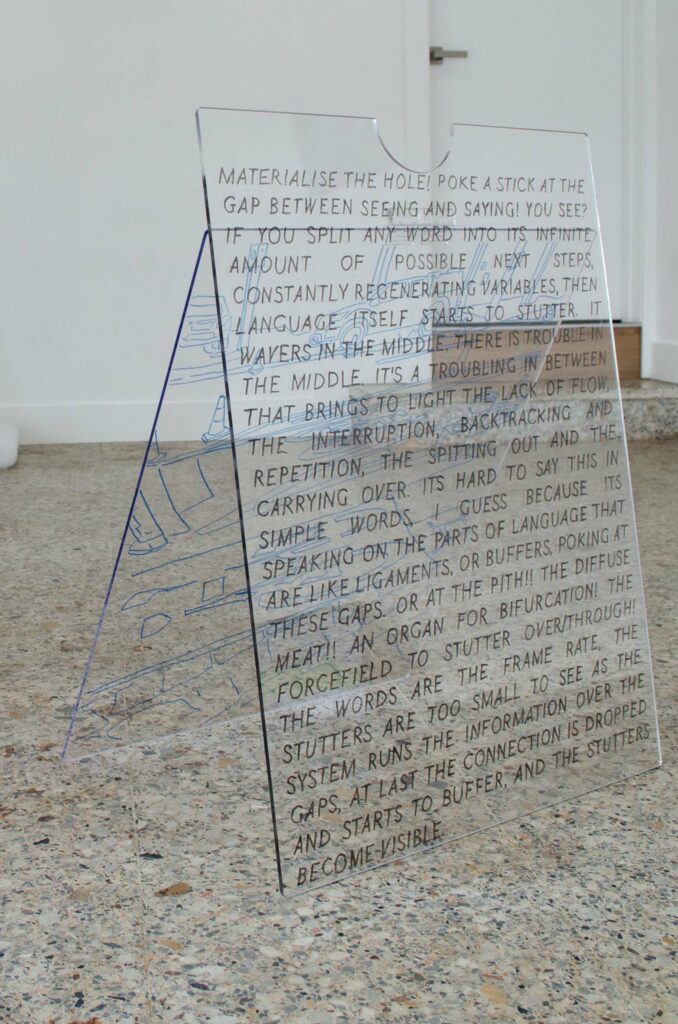
From the plexiglass centrepiece, language begins to spiral outwards, as new words enter the lexicon and as multiple variations on a single starting point occur. But as the lexicon grows I ask: can we turn back and locate that precise starting point, or has it now changed beyond recognition? What is it made of? The later declaration, ‘IT WAVERS IN THE MIDDLE. THERE IS TROUBLE IN THE MIDDLE’, points to the ineffability of this meeting point. What is this place? What is the sinewy thing that fuses together the work of more than one person?
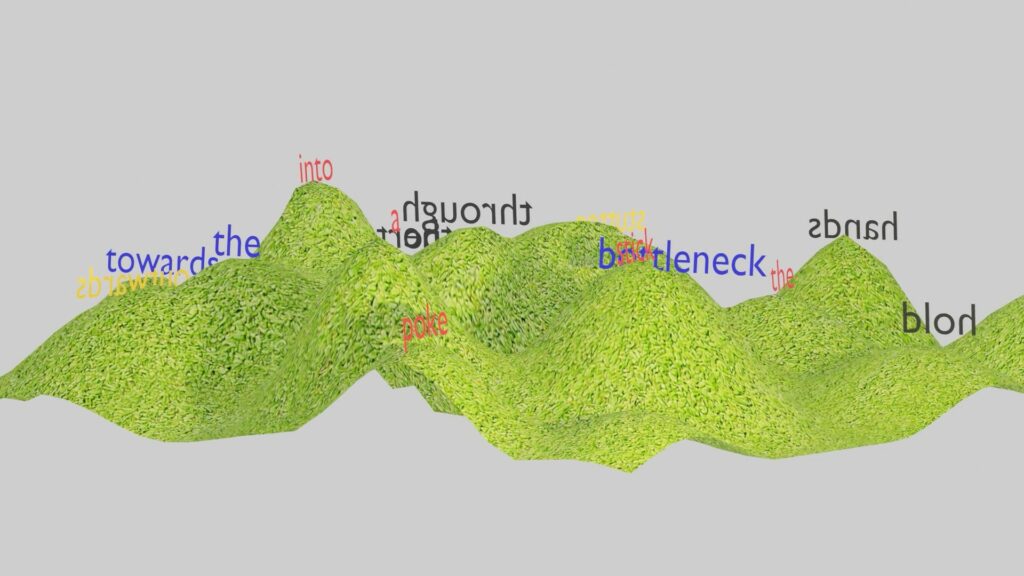
On the back wall, melty craft beads have been assembled to create an image that looks computer-generated. A large pixellated rock interrupts a similarly pixellated stream of water, as it begins to splay outwards around and from the rock. Above, the text reads, ‘start to stutter’. A stutter is a disfluency, an interruption in the regular flow of things. But when I think about stuttering conceptually I also think of the length of individual sounds in morse code, or the variable crack through which light enters an analogue photograph; I think of the deliberate uses of such interruptions. Altering the signal duration in a particular part of a morse code sequence will wield a different end result from which a particular sentence can be inferred. Increasing the amount of light allowed into a camera lens will often produce a sharper focal point in an image. These are tools that can be intentionally manipulated to create the desired effect. Similarly, Moriarty and Berry want us to consider ‘the parts of language that are like ligaments, or buffers’. These kinds of stutters, or minute interstices, will do something to a person’s perception of overall meaning.
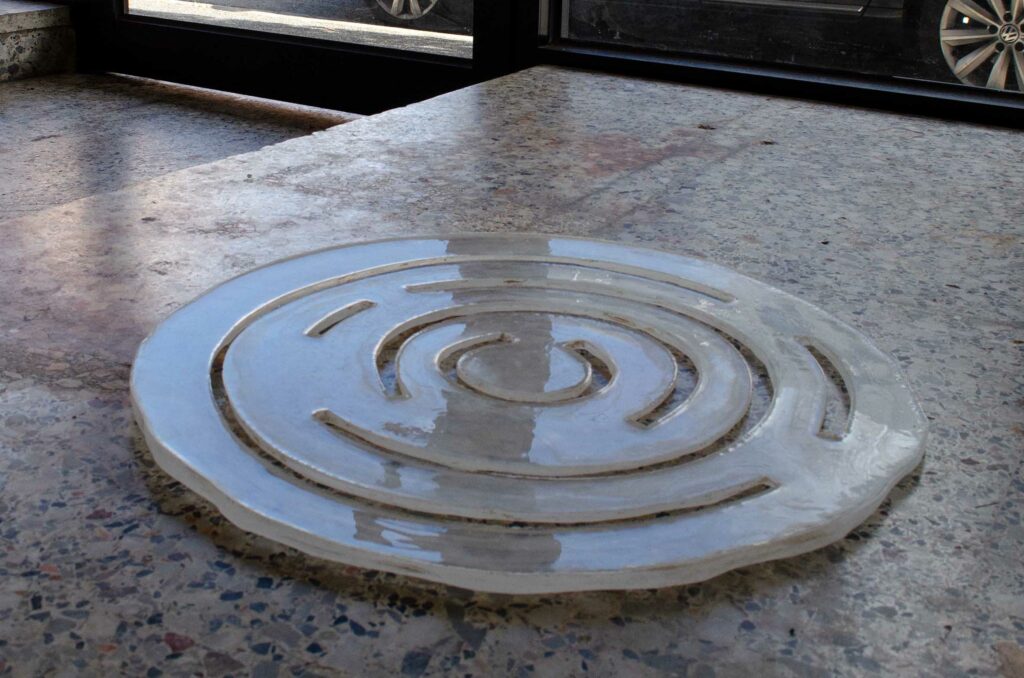
The artists track and share their paths via documentation: a photograph of a cloudy sky from a walk around the block, a question written in a notes app to be answered later. I think of poet Mary Oliver famously carrying a notebook with her while walking in the woods, often physically writing and walking at the same time. The rhythm and repetition of movement generated ideas and connections she could scribble down to use later. In a sense this practice is a type of foraging, searching the landscape for poetic material. The work in Starting in the Middle also comes out of a type of foraging, asking, how did we get here? Have the streets been ingrained into deep muscle memory? How long does it take to forge a path? Did I fall asleep in the back seat while the car drove on? Through these shared observations it becomes evident that the work of this show stands on the outer edges of a central, underlying process of collaborative writing.
Poetry is a buildable practice—‘a pile built from words’—often beginning from one central idea. The role of poetics in Moriarty and Berry’s respective practices is as much a subject as a method; it is a way of processing the world. In the work, we see evidence of stream-of-consciousness writing, and of observational note-taking. Poetry as a sensory lens through which to go about your day, poetry as a portal. A playful example sits against the right wall—a screen displaying the image of a rotating hilly landscape in which isolated words hover over each slope. The words: through, portal, into, stutter, bottleneck, outwards, and poke all invoke movement and directionality. Then there are the filler words, the conjunctions, the tissue surrounding the joint: the, and, and a. It is graphically simple, creating the joyful feeling of wandering through a landscape made of ever-changing, jumbled words. Language is a porous thing: it is in a constant and absorptive state of change, depending on its environment.
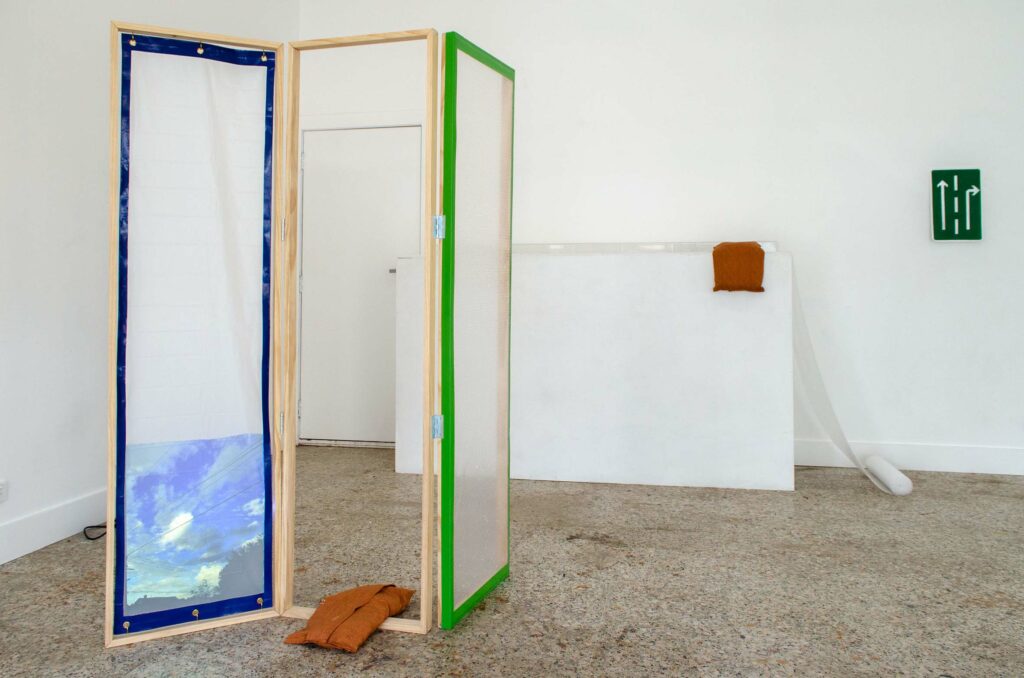
On the floor sits a circular, slightly transparent, not-quite-a-maze sculpture—a portal. We also see a road sign with two arrows that indicate a bifurcating road up ahead. We have recurring motifs of water, flow, circles, and maps. We see a Texta-drawn outline—simple yet spatially accurate, at least to the naked eye—of a winding suburban footpath, as if one artist has gone for a walk and now they can tell the other which way to go. This attention to map-making gives me the feeling of being in a practice bike-riding school, with signs and directives that mimic the real world, offering a simplicity that allows me to pass through the exhibition with ease. This is not a once-off collaboration; it is the culmination of a time span of several years, and over this time, a kind of language ecosystem has formed: winding through hills, stuttering across cartographic terrain, echoing through portals and along valleys.
What we are left with is the sensation of always circling back to that unnameable place of mutuality: my art sustains you and your art sustains me. And perhaps an acceptance that it is impossible to control expression. So much is happening underneath language—speculation, guesswork, interpretation. By allowing us to reflect on the way connection can shape language, Starting in the Middle gives the sense that collaboration is not the means to a final outcome but a never-ending outward ripple.
Charlotte Kerr is a writer and poet with a background in theatre, music and performance. She lives and works on unceded Wurundjeri Country.
This text was commissioned through the Emerging Writers’ Program. An annual collaborative project, from KINGS and un Projects, that supports critical arts writing, fiction, poetry, experimental, cross-genre and digital text forms. The Emerging Writers’ Program provides professional publishing opportunities and fosters dialogue between artists and arts writers. Each emerging writer in the program receives critical feedback and editorial assistance from KINGS and un Projects personnel.
In 2022, the KINGS Artist-Run Emerging Writer’s Program is supported by Creative Victoria through their Sustaining Creative Workers initiative.
